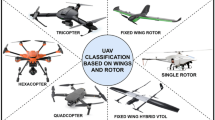Abstract
Unmanned Aerial Systems (UASs) have rapidly grown into a significant part of the world-wide aviation budget. However, regulations and official standards have lagged significantly. Within the U.S., there has been significant pressure to develop the regulations to allow commercial and governmental agencies to utilize UASs within the National Airspace System (NAS). The authors propose a concept of operation document that incorporates existing regulations and ensures an acceptable level of performance based on experience with a Personal Remote Sensing (PRS) Unmanned Aerial System (UAS).
Similar content being viewed by others
References
Fact Sheet—Unmanned Aircraft Systems (UAS). Available: http://www.faa.gov/news/fact_sheets/news_story.cfm?news_story.cfm?newsId=6287 (2010)
Hill, K.: Congress Welcomes The Drones, pp. 1–5. Available: http://www.forbes.com/sites/kashmirhill/2012/02/07/congress-welcomes-the-drones/ (2012)
Tarbert, B., Wierzbanowski, T., Chernoff, E., Egan, P., Fagan, M., Haase, C., Hackman, R., Hanson, R., Lacher, A., Marks, F., Marshall, D., Mcduffe, P., Mcgeer, T., Roberts, A., Shinnamon, D., Schultz, D., Wheeler, W., Williams, A., York, D.: Comprehensive Set of Recommendations for sUAS Regulatory Development. SmallUnmannedAircraft SystemAviation Rulemaking Committee (2009)
Airspace Integration Plan for Unmanned Aviation. Office of the Secretary of Defense, Tech. Rep. (2004)
Unmanned Aircraft System Airspace Integration Plan. Department of Defense, Tech. Rep. (2011)
Center for Self-Organizing and Intelligent Systems. Available: http://www.csois.usu.edu/ (2012)
AggieAir Flying Circus. Available: http://aggieair.usu.edu/ (2012)
Jensen, A.M., Chen, Y., McKee, M., Hardy, T., Barfuss, S.L.: AggieAir—a low-cost autonomous multispectral remote sensing platform: new developments and applications. In: Proc of 2009 IEEE International Geoscience and Remote Sensing Symposium, pp. IV-995–IV-998. Available: http://ieeexplore.ieee.org/lpdocs/epic03/wrapper.htm?arnumber=5417547 (2009)
STANAG 4671: Unmanned Aerial Vehicles Systems Airworthiness Requirements. Tech. Rep. (2009)
MIL-STD-2161B(AS): Paint schemes and exterior markings for U.S. Navy and Marine Corps aircraft. Department of Defense, Tech. Rep. (2008)
MIL-F-8785C: Flying qualities of piloted airplanes. U.S. Department of Defense, Tech. Rep. (1980)
Phillips, W.F.: Mechanics of Flight, 2nd edn. Wiley, Hoboken (2010)
Paparazzi UAS Project. Available: http://paparazzi.enac.fr/wiki/Main_Page (2012)
Ebdon, D., Regan, J.: WHITE PAPER: sense-and-avoid requirement for remotely operated aircraft (ROA). Tech. Rep. (2004)
Kephart, R.J., Braasch, M.S.: See-and-avoid comparison of performance in manned and remotely piloted aircraft. Electronics (May), 25(5), 36–42 (2010)
Williams, K.W.: A summary of unmanned aircraft accident/incident data: human factors implications. Office of Aerospace Medicine, Tech. Rep. (2004)
Shappell, S.A.: The human factors analysis and classification system. FAA Civil Aeromedical Institute, Oklahoma City, OK, Tech. Rep. (2000)
Manning, S.D., Rash, C.E., LeDuc, P.A., Noback, R.K., McKeon, J.: The role of human causal factors in U.S. Army unmanned aerial vehicle accidents. U.S. Army Medical Research and Material Command, Tech. Rep. (2004)
Glussich, D., Histon, J.: Human/automation interaction accidents: implications for UAS operations. In: Proc of 2010 IEEE/AIAA 29th Digital Avionics Systems Conference (DASC), Salt Lake City, UT, pp. 4.A.3-1–4.A.3-11 (2010)
Author information
Authors and Affiliations
Corresponding author
Rights and permissions
About this article
Cite this article
Stark, B., Coopmans, C. & Chen, Y. Concept of Operations for Personal Remote Sensing Unmanned Aerial Systems. J Intell Robot Syst 69, 5–20 (2013). https://doi.org/10.1007/s10846-012-9710-9
Received:
Accepted:
Published:
Issue Date:
DOI: https://doi.org/10.1007/s10846-012-9710-9




